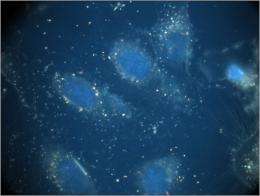To Attack H1N1, Other Flu Viruses, Gold Nanorods Deliver Potent Payload

(PhysOrg.com) -- Future pandemics of seasonal flu, H1N1 and other drug-resistant viruses may be thwarted by a potent, immune-boosting payload that is effectively delivered to cells by gold nanorods, report scientists at the University at Buffalo and the U.S. Centers for Disease Control and Prevention. The work is published in the current issue of the Proceedings of the National Academy of Sciences.
"This joint research by UB and the CDC has the potential to usher in a new generation of antiviral medicines to aggressively treat a broad range of infectious diseases, from H1N1 to avian flu and perhaps Ebola, that are becoming increasingly resistant to the medicines used against them," says UB team leader Paras Prasad, PhD, executive director of the UB Institute for Lasers, Photonics and Biophotonics (ILPB) and SUNY Distinguished Professor in the departments of Chemistry, Physics, Electrical Engineering and Medicine.
The collaborative work between UB and CDC came together through the work of Krishnan Chakravarthy, an MD/PhD candidate at UB and the paper's first author. This research constitutes part of his doctoral degree work that focused on host response to influenza infection and novel drug delivery strategies.
The paper describes the single strand RNA molecule, which prompts a strong immune response against the influenza virus by ramping up the host's cellular production of interferons, proteins that inhibit viral replication.
But, like most RNA molecules, they are unstable when delivered into cells. The gold nanorods produced at UB act as an efficient vehicle to deliver into cells the powerful immune activator molecule.
"It all boils down to how we can deliver the immune activator," says Suryaprakesh Sambhara, DVM, PhD, in CDC's Influenza Division and a co-author on the paper. "The UB researchers had an excellent delivery system. Dr. Prasad and his team are well-known for their contributions to nanoparticle delivery systems."
A key advantage is gold's biocompatibility.
"The gold nanorods protect the RNA from degrading once inside cells, while allowing for more selected targeting of cells," said co-author Paul R. Knight III, MD, Chakravarthy's thesis advisor; professor of anesthesiology, microbiology and infectious diseases in the UB School of Medicine and Biomedical Sciences; and director of its MD/PhD program.
"This work demonstrates that the modulation of host response is going to be critical to the next generation of anti-viral therapies," Chakravarthy explains. "The novelty of this approach is that most of these kinds of RNA viruses share a common host-response immune pathway; that is what we have targeted with our nanoparticle therapy. By enhancing the host immune response, we avoid the difficulty of ongoing viral resistance generated through mutations."
Diseases that could be effectively targeted with this new approach include any viruses that are susceptible to the innate immune response that type 1 interferons trigger, Prasad notes.
Based on these in vitro results, the UB and CDC researchers are beginning animal studies.
"This collaboration has been extraordinary as two disparate research groups at UB and a third at the CDC have managed to maintain progress toward a common goal: treatment of influenza," says co-author Adela Bonoiu, PhD, UB research assistant professor at ILPB.
Important funding for the UB institute portion of the research was provided by the John R. Oishei Foundation, which helped pave the way for new stimulus funding UB received recently from the National Institutes of Health to further develop this strategy. The goal is to work toward an Investigational New Drug filing with the FDA.
Provided by University at Buffalo
















